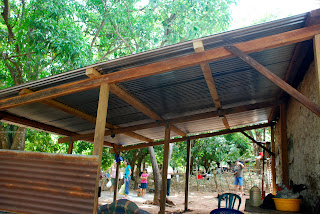Before we began our trip I wondered if we could truly make a difference in two short weeks. What we found is that yes, we did make a difference. We came to Guatemala to build two homes, but we experienced so much more; we saw so much more.
We made a difference by hosting the medical clinic; people who don’t have access to medical care were assessed and provided with information, basic health care, and medications. People who can’t afford clothing were given clothes. People who are struggling to exist were shown that others care.
We made a difference to some of the prostitutes. They were provided with a meal and with care packages. These ladies who are often shunned, were shown love and acceptance.
We made a difference to the sponsor families. As we visited with them we took them clothing, linens and toys. Some came to the base to learn a craft and to pick up food packages. All were shown love and acceptance.
We made a difference to Maria and her family. Maria lived with her daughter, son-in-law and children; only days before we arrived in Guatemala Maria’s son-in-law was murdered. The team reached out and visited the family, taking supplies and toys. The porch on the home was ready to collapse; the men on the team tore it down and rebuilt a new one. On one home visit we brought the children back to the clinic and tended to their problems. The little boy had fallen and scabbed his knee – five days later it was very infected. The little girl’s nose was filled with dried blood and she had sores on her face that were becoming infected. Neither of the children were eating, their intestinal problems likely due to parasites. At a time when this family was grieving, and was unable to meet basic needs, food, clothing, shelter and health care was provided. This support meant so much to the family.



We made a difference to the Casa Esperanza children. We played with them, hugged them, and developed relationships with them. Sonja, one of the older girls gave us thank-you letters expressing her gratitude; the hugs from all the children as we said our good-byes touched our hearts.



We made a difference to the members of the community. Many thanked us for coming, for helping the community, for caring, for making a difference.
And we will make a difference to the lives of the families who will eventually move into the two homes that we raised money for and built. So yes, we did make a difference.
The trip also made a difference in each one of us. We came to Guatemala to build two homes, but the experiences we had touched our hearts. As we go back home, we have a choice to make. We can say “that was a good trip” and leave it at that, or we can say “we want to continue to make a difference”. I hope we don’t forget our experiences; I hope we continue to make a difference. I hope more people choose to make a difference in whatever way they can, for there is definitely no shortage of needs.


































